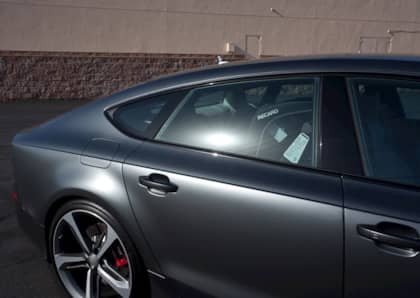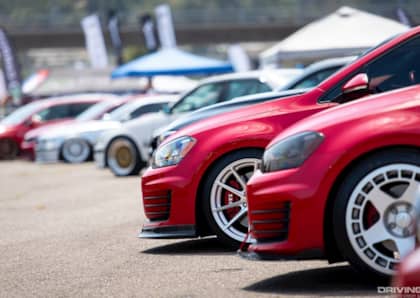V10 Countdown: 5 Of The Mightiest 10 Cylinder Performance Engines Ever Built
Although automotive history is filled with V8 and even V12 sports cars, there aren't nearly as many 10 cylinder examples out there. Early on, V10 engines weren't considered smooth enough in operation to justify their production when balanced 8 and 12-cylinder options were available, but modern production techniques—coupled with the fact that it it's relatively simple to turn an existing V8 into a V10 by adding a couple of extra cylinders to the block—made them far more viable for performance-seeking engineers looking to shake up the status quo. Throw in Formula 1's decade of V10 drivetrain research, and the field opened up dramatically
Which V10 sports cars offered the most impressive horsepower? These are our favorite 10 cylinder monsters.
Dodge Viper V10
When Chrysler began developing the Viper at the end of the '80s, the largest engine it had available was the legacy LA family V8, which topped out in 5.9L trim.

Eager to give the exotic enough punch to flatten the Chevrolet Corvette in a straight line, it was decided to kill two birds with one stone: provide Dodge's pickup truck division with a 10-cylinder motor based on the LA design, while simultaneously working with Lamborghini (which was owned by Chrysler at the time) on an aluminum version of the same general idea.

The 8.0L V10 that ended up under the Viper's clamshell hood was based on a 5.9L block that had been gifted with two additional cylinders. The motor also offered a longer stroke, dual valve springs, and swapped its iron block, pistons, and heads for Lamborghini-designed aluminum. The end result was a 400hp unit that was also good for just over 450 lb-ft of torque.

Over the ensuing years, Dodge would stick with the Viper's original engine design, boosting displacement all the way up to 8.4 liters and pushing power to 640 horses and 600 lb-ft of twist by the time the fifth generation car debuted as a 2012 model.
Porsche Carrera GT V10
In the mid-90s Formula 1 racing went to a 10-cylinder engine package, and as a result a number of automakers involved in the series began to develop motors that would eventually trickle down to their street vehicles.

Porsche's V10 was based on a never-raced 3.5-liter F1 design that had been built nearly a full decade before the Carrera GT sports car made it to showrooms.

In the intervening years it had been repurposed for LMP2000 competition, and then in the Carrera GT concept in 2000, (in 5.5-liter form), before finally growing to 5.7-liters when Porsche's mid-engine marvel went on sale for the 2004 model year.

Capable of 603 horsepower and 435 lb-ft of torque, the Porsche Carrera GT's V10 was famously unrestricted by any type of traction control system, and production was eventually capped at fewer than 2,000 examples.
BMW M5/M6 V10
Like Porsche, BMW's V10 was a product of F1 competition.

Unlike its in-country rival, however, the 5.0L motor (known internally as the S85) was designed specifically for the street using hard-won experience from actual Formula One campaigning.

Specifically, it drew most heavily from the BMW Williams 3.0L V10 that was retired after 2005, was made out of aluminum, and featured four valves per cylinder and variable-valve timing. Of particular note were its 10 individual throttle bodies, providing exceptional pedal response and a unique look under the hood once you've removed the cover and air boxes.

Unrelated to any other engine in the BMW portfolio, the S65 was installed in the M5 sedan and the M6 coupe from 2005 to 2010. Output was a healthy 500hp and 384 lb-ft of torque with a redline of over 8,000 rpm, which made the motor remarkably different in character from other luxury sports models of the day. It was also one of the last naturally-aspirated engines to be found in an M car.
Audi R8/S8/S6/RS6 and Lamborghini Gallardo/Huracan V10
Audi was much more generous in spreading around its high performance V10 engine technology than either BMW or Porsche.

Not only did the 5.2L unit find its way between the front fenders of the S8 full-size sedan and the somewhat smaller S6 sedan and wagon, but a version also ended up being dropped behind the driver the R8 super car as well as its Lamborghini Huracan platform sibling. There was even a V10 found in the Audi RS6 that leaned hard on the Lambo-heritage motor for motivation, starting at around the mid-point of the first decade of the 2000s.

The original-spec for Audi's 5.2L V10 was 444hp and 398 lb-ft of torque, which were massive numbers when the S8 and S6 debuted in 2006. The motor itself was linked to the 5.0L 10-cylinder engine that had gone on sale a few years beforehand with the Lamborghini Gallardo, with the Italian company having fully transitioned to Volkswagen Group ownership. In the supercar, the motor provided between 493 and just over 520hp, depending on the model year.

There were many tweaks and twists to the Audi/Lamborghini V10 over the years. The RS6 sedan and wagon would feature a twin-turbo version of the 5.0L motor that was good for a startling 571hp, but eventually the entire line-up would move to the 5.2Ldesign. For Lamborghini, this meant up to 630hp in the range-topping Huracan LP640, while the Audi R8 coupe and convertible (introduced just after the S8) would eventually graduate to a similarly-mighty edition of the same motor by the end of its second generation.
Lexus LFA V10
The last entry on our list of the most powerful V10 engines to have ever been unleashed in street cars has only a subtle tie to the world of F1.

Although Toyota had very little luck in conquering one of the most challenging motorsports series in the world during its V10 period, it did better in showrooms with the Lexus LFA. This extremely limited production sports coupe, despite its unusual lease program during its initial sales period, became widely respected as a high end driver's car.

Powering the front-engine LFA was a 4.8L V10 that provided 552hp and 354 lb-ft of torque. Although not directly linked to Toyota's F1 program, there were numerous aspects of its character (particularly its sound) intended to reflect the company's racing exploits, while at the same time keeping vibration, and harshness within the limits expected by a Lexus customer.

Like the Honda S2000, you really had to wring the engine's neck for maximum performance, as its peak production didn't occur until an eye-popping 8,700 rpm. The all-aluminum engine also adopted a somewhat unusual 72-degree angle for its cylinder banks. Developed in conjunction with Yamaha, which had a solid reputation for one-off engine designs, the vehicle would see nearly a decade of engineering refinement before it was finally introduced in 2009.
More From Driving Line
- Looking for more high performance engine history outside the traditional V8 spectrum? Check out these forgotten hunks of Detroit iron.











